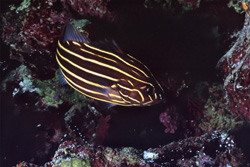Discover the Fascinating Six-striped Soap Bass – A Masterpiece of Marine Fauna with Distinctive Features and Ecological Value.
The Six-striped Soap Bass (scientific name: Ambassis sexstripe) is a remarkable representative of marine fauna, distinguished by its characteristic six horizontal stripes. These stripes not only provide the fish with an aesthetically pleasing appearance but also play a crucial role in camouflage and communication within its species. The six-striped soap bass primarily inhabits shallow coastal waters and coral reefs, where it feeds on small crustaceans and plankton. Its adaptability to various habitats makes it an important indicator of the health of marine ecosystems. Additionally, the fish contributes to the stability of food webs and supports the biodiversity of the regions it inhabits. Due to its economic significance for local fishing communities, protecting the six-striped soap bass is essential for sustainable marine resource management strategies. Research indicates that changes in the populations of this fish can signal ecological shifts and environmental stressors. Therefore, the six-striped soap bass is not only a fascinating subject for marine biologists but also a key indicator for the long-term sustainability of marine habitats. Conservation efforts for this species include the establishment of marine protected areas, fishing regulations, and water quality monitoring. Culturally, the six-striped soap bass features in local traditions and is often depicted in regional art and folklore. Its symbolic presence represents the diversity and resilience of marine ecosystems, which are vital for the global ecological balance. Overall, the six-striped soap bass is an indispensable component of marine biodiversity, and its preservation is crucial for the health of the oceans and human societies.

